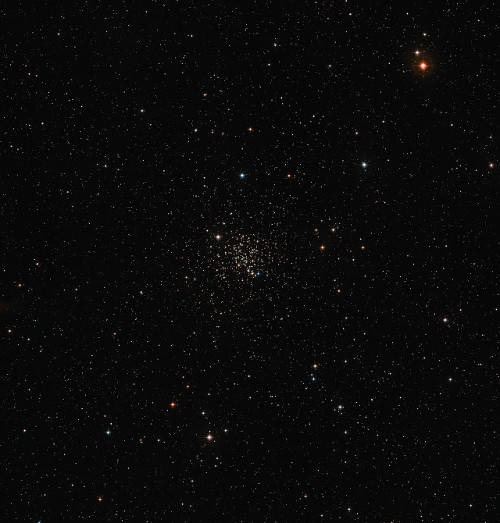Centauri Dreams
Imagining and Planning Interstellar Exploration
HD 142527: An Unusual Circumstellar Disk
Conventional models of planet formation involve core accretion, where dust grains accumulate into protoplanets whose subsequent collisions and interactions produce planets, or gravitational instability, involving a rapid collapse from dense disk debris into a planetary core. But how far from the parent star does planet formation occur? The more we learn about protoplanetary disks, the more questions individual systems pose, as illustrated by the discovery highlighted today.
I’m looking at the image of a young star called HD 142527 in the constellation Lupus, some 450 light years from Earth. The T Tauri star, some five million years old, is thought to be of about two solar masses. A team of Japanese astronomers using observations from the Atacama Large Millimeter/submillimeter Array (ALMA) has found an asymmetric ring of dust that appears, based on the density of dust in the densest part of the ring, to be producing planets. A previously discovered inner disk is confirmed by this work, but the kicker is that there appears to be a possible planet formation region about 160 AU out, five times the distance between Neptune and the Sun.
The paper on this finding notes that “…the pile-up of disk material beyond 100 AU is quite surprising in the classical scenario of planet formation.” Munetake Momose, a team member and a professor at Ibaraki University, adds this:
“Seeing the site of planet formation directly is one of the most important goals for ALMA. Our observations successfully located a unique candidate in an unexpectedly distant place from the central star. I believe that ALMA will bring us more surprising results.”
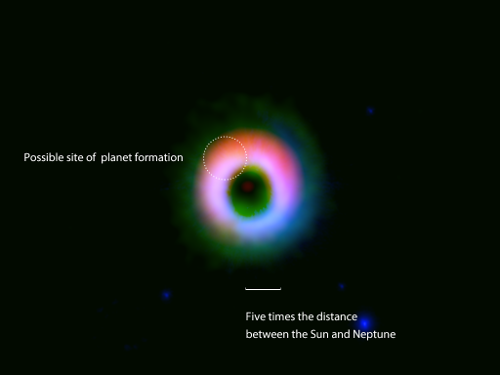
Image: Dust and gas disk around HD 142527. The dust and gas distributions observed by ALMA are shown in red and green, respectively. A near-infrared image taken by the NAOJ Subaru telescope is shown in blue. The image clearly shows that the dust is concentrated in the northern (upper) part of the disk. The circle in the image shows the position of the dust concentration, in which planets are thought to be formed. Credit: ALMA (ESO/NAOJ/NRAO), NAOJ, Fukagawa et al.
This news release from the National Astronomical Observatory of Japan points out that near-infrared observations cannot penetrate the innermost part of the dense region of a protoplanetary disk — near-infrared light is easily absorbed by large amounts of dust. ALMA’s millimeter and submillimeter wavelength observations — these wavelengths are poorly absorbed by dust — allow better resolution of the inner part of the disk. The ring around HD 142527 shows one side that is thirty times brighter than the other. Misato Fukagawa leads the team:
“The brightest part in submillimeter wave is located far from the central star, and the distance is comparable to five times the distance between the Sun and the Neptune. I have never seen such a bright knot in such a distant position. This strong submillimeter emission can be interpreted as an indication that large amount of material is accumulated in this position. When a sufficient amount of material is accumulated, planets or comets can be formed here. To investigate this possibility, we measured the amount of material.”
The researchers, from Osaka University and Ibaraki University, estimate based on the submillimeter emission strength that the dense region under investigation is massive enough to produce giant planets more massive than Jupiter through gravitational instability. But a high enough density of dust in the same region could readily produce smaller rocky planets or the cores of gas giants through core accretion processes. It’s worth noting that a 2013 paper has examined planet formation close to this star; the new work extends to the outer disk.
So HD 142527 seems a promising place for follow-up work, an opportunity to observe critical aspects of the planet formation scenario at considerable distances from the host star. Most ring-like disks under observation have proven to be smaller in mass, lacking the intensity of the brightness fluctuations found around this star, not to mention the disk’s striking asymmetry. New measurements of the gas in this disk using ALMA are being undertaken as the team tries to resolve which of the planet formation processes is taking place around the star.
The paper is Fukugawa et al., “Local Enhancement of Surface Density in the Protoplanetary Ring Surrounding HD 142527,” published in Publications of the Astronomical Society of Japan, on December 25th, 2013 (preprint). The 2013 paper on this system is Casassus et al., “Flows of gas through a protoplanetary gap,” Nature 493 (2 January 2013), pp. 191-194 (abstract).

A Brown Dwarf Benchmark
Couple the Keck I 10-meter telescope on Mauna Kea with HIRES (the High-Resolution Echelle Spectrometer) and you get extremely high spectral resolution, making the combination a proven champion at finding planets around other stars. But it was when Justin Crepp (University of Notre Dame) and team followed up seventeen years of HIRES measurements with new observations using NIRC2 (the Near-Infrared Camera, second generation), mounted on the Keck II telescope with adaptive optics, that a nearby brown dwarf could be directly imaged.
HD 19467 B is a T-dwarf more than 100,000 times fainter than its host, a nearby star whose distance (roughly 101 light years) is well established. The team believes the discovery will allow scientists to establish benchmarks that will help define objects with masses between stars and planets. Says Crepp:
“This object is old and cold and will ultimately garner much attention as one of the most well-studied and scrutinized brown dwarfs detected to date. With continued follow-up observations, we can use it as a laboratory to test theoretical atmospheric models. Eventually we want to directly image and acquire the spectrum of Earth-like planets. Then, from the spectrum, we should be able to tell what the planet is made out of, what its mass is, radius, age, etc., basically all relevant physical properties.”
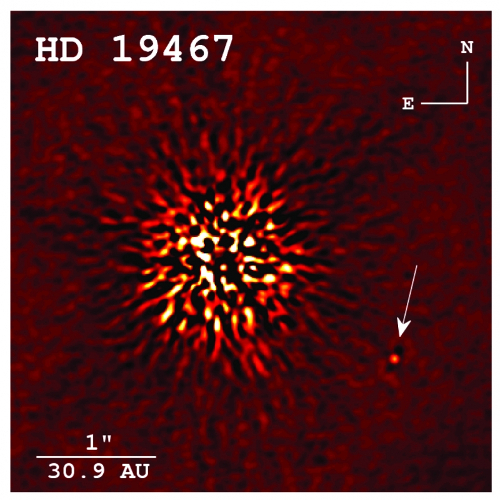
Image: Direct image detection of a rare brown dwarf companion taken at Keck Observatory. Stellar speckles have been removed using PSF subtraction [used to study faint features around bright objects]. The companion is 100,000 times fainter than its host star in the K-band. Credit: Crepp et al./ 2014 APJ.
The work grows out of TRENDS (TaRgetting bENchmark-objects with Doppler Spectroscopy), a high-contrast imaging survey using adaptive optics to target older objects orbiting nearby stars. Imaging surveys like these have in general targeted young stars, but TRENDS focuses on older targets for which the existence of an unseen companion has been suggested by earlier radial velocity data. The paper on this work notes that our ability to see these older, fainter objects is improving with recent advances in high-contrast imaging techniques and hardware.
TRENDS looks for faint companions and thus far has uncovered a number of high mass ratio binary stars, a triple star system (HD 8375) and a white dwarf companion orbiting HD 114174. But here’s why Crepp speaks of using this brown dwarf discovery as a model. From the paper:
By connecting the properties of directly imaged companions to that of their primary star (such as metallicity and age), these objects serve as useful test subjects for theoretical models of cool dwarf atmospheres… Further, the combination of Doppler observations and high-contrast imaging constrains the companion mass and orbit, essential information that brown dwarfs discovered in the field or at wide separations by seeing-limited instruments do not provide.
I learned from the paper that while many nearby brown dwarfs have been discovered by surveys scanning large areas of the sky at optical, near-infrared and mid-infrared wavelengths, only a few are members of multiple systems. Even these are at large separations from the host star given that the glare of the primary makes it so difficult to see ultra-cold dwarfs in closer orbits. The significance of HD 19467 B, then, is that this is the first directly imaged T-dwarf orbiting a Sun-like star with a measured Doppler acceleration, meaning it will be among the first to have a dynamically measured mass. As studies continue, what Crepp and team have found should turn out to be an important benchmark in the investigation of how brown dwarfs evolve.
The paper is Crepp at al., “The TRENDS High-Contrast Imaging Survey. V. Discovery of an Old and Cold Benchmark T-dwarf Orbiting the Nearby G-star HD 19467,” The Astrophysical Journal Vol. 781, No. 1 (2014), p. 29 (abstract / preprint).

Waking Up Rosetta
In the first post of 2014, I wrote about what the following year — 2015 — would bring, the New Horizons flyby of Pluto/Charon as well as the arrival of the Dawn spacecraft at Ceres, a fascinating object with a possible internal ocean. But let’s not forget about the European Space Agency’s Rosetta spacecraft, which is now nearing the end of a decade-long journey to comet 67P/Churyumov-Gerasimenko. The spacecraft is scheduled to awake from a two-year stretch in sleep mode today, with arrival at the comet’s core in November. The orbiter will operate there until the end of 2015.
We’ve had missions to comets before, many of them discussed in these pages, but none as ambitious as this one. Rosetta’s Philae lander will attempt a landing on the comet in November while the orbiter will continue tracking it as the comet is transformed by its approach to the Sun into an erupting, churning mass of ice and dust. With gravity about a thousand times less than that of Earth, this is a tricky object to land on, but the visual rewards should be great, according to Michael Combi (University of Michigan), a co-investigator on several instruments aboard the craft:
“On the lander, there’s a camera that can look straight down like you’re standing up and looking at the ground. Then there’s a panoramic camera that can look out and see a picture of the horizon. It’ll be fun to see what this landscape looks like. It’ll be like standing on a comet.”

Image: An artist’s interpretation of the Rosetta mission lander, named Philae, on the core of comet 67P/Churyumov-Gerasimenko. It’s expected to land in November. Credit: ESA / AOES Medialab.
Rosetta’s investigations will be numerous, and many bear directly on issues we routinely discuss here. We’ve been looking, for example, at Pekka Janhunen’s concept of an electric sail that would ride the solar wind — a stream of charged particles flowing outward from the Sun — to distant destinations in the Solar System, reaching perhaps 100 kilometers per second. Rosetta will be studying the interactions of the solar wind with cometary gases to learn more about the composition of the charged particles and help us better understand solar storms.
That’s the kind of space ‘weather’ an electric sail would confront as it makes its long journey to system’s edge. This University of Michigan news release notes that the solar wind travels more slowly from the area of the Sun’s equator, but moves much faster at higher latitudes. Comets pass through a wide range of solar wind conditions and thus offer an ideal way to study the phenomenon. Accurate control and navigation of future craft riding the solar wind will depend upon our understanding of its turbulent interactions.
Comets are also useful in teaching us about the origin and evolution of the Solar System, as they were present in the nebula from which the system grew and have been orbiting far from the Sun ever since. We still have much to learn about their role in delivering water to Earth’s oceans and possibly organic materials. Combi adds: “People use the analogy that it’s been in the freezer for the past 4.5 million years and brought in for convenient study. So we’re looking as much as we can at the way the way the solar system was 4.5 billion years ago.”
This recent NASA news release offers information about the three instruments the agency has contributed to the ESA mission:
- An ultraviolet spectrometer called Alice, which analyzes the ultraviolet part of the spectrum, examining gases in the coma and tail to measure the water, carbon monoxide and carbon dioxide it finds there, along with other readings on the surface composition of the nucleus;
- The Microwave Instrument for Rosetta Orbiter, combining a spectrometer and radiometer to read temperatures and identify chemicals on the comet’s surface and the dust and ices around it. This will be a key instrument in tracking changes as the comet approaches the Sun;
- The Ion and Electron Sensor, used in characterizing the plasma environment of the comet and the interactions of the solar wind with the comet’s gases.
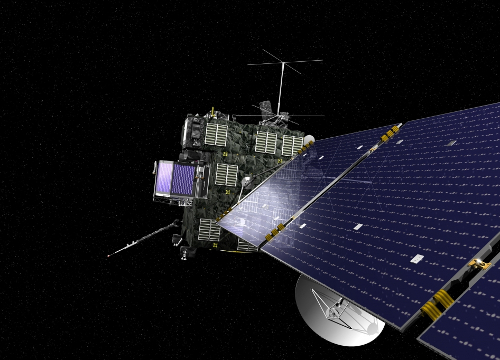
Image: An artist’s view of Rosetta, the European Space Agency’s cometary probe. The spacecraft is covered with dark thermal insulation in order to retain its warmth while venturing into the coldness of the outer solar system, beyond Mars orbit. Credit: ESA.
The European Space Agency’s Rosetta page is here, a place you’ll want to bookmark as the year progresses and Rosetta moves ever closer to its encounter with 67P/Churyumov-Gerasimenko. Thus far the spacecraft has made three Earth flybys and one flyby of Mars as it established its trajectory to the comet, with encounters with asteroids Steins and Lutetia along the way. Assuming all is going well, the spacecraft’s star trackers are now warming up, a six hour process, and adjustments will soon be made to its orientation to keep Rosetta’s solar arrays facing directly toward the Sun. Follow @ESA_Rosetta for confirmation that the wake-up procedure is complete, probably between 1730 and 1830 UTC. Keep an eye on this page for live video updates.

Stepping Stones Across the Cosmos
by J. N. Nielsen
Nick Nielsen thinks big. In fact, today’s essay, which ranges over vast stretches of time and space and places human civilization in a continually expanding context, reminds me of nothing so much as the Olaf Stapledon of Starmaker. As with Stapledon, the questions are deeply philosophical: If we find a way to travel arbitrarily close to the speed of light, thus creating a civilization Carl Sagan once envisioned — one spread not only over space but over aeons — how will we cohere as a species? And what forms will our migrations take after the first pioneers have left our niche in the cosmos behind? For more of Nielsen’s work, see his blogs Grand Strategy: The View from Oregon and Grand Strategy Annex.

In my previous Centauri Dreams post, Cosmic Loneliness and Interstellar Travel, I argued that our cosmic loneliness is the reason we seek peer species and peer civilizations in the universe, that interstellar travel is a more practicable way to explore the universe for intelligent life than SETI/METI communication, and that such travel will eventually result as a consequence of the development of a 1G starship (a spacecraft that can accelerate or decelerate at a rate equal to terrestrial gravity). In my Centauri Dreams post prior to that, SETI, METI, and Existential Risk, I argued that SETI efforts will find technological civilizations if they are out there, and, by the same token, we will be found whether we want to be found or not, but we ought not to shrink from this possibility because the potential risk is at the same time a civilizational opportunity.
In this present post I would like to explore what kind of large-scale spacefaring civilization would emerge from the positions I have taken in the previous posts, specifically, the idea that we would be found by advanced civilizations if there were any, but we haven’t been found. I would like for these three Centauri Dreams posts to be understood as one long argument (as Darwin said of his Origins), and the argument is this: if it makes more sense to travel than to communicate, and if there is no sign of travel to Earth by extraterrestrial civilizations, then we are alone, or very nearly alone, in the cosmos. We may not be absolutely alone in the universe, but we are likely to be sufficiently alone that we can embark upon the initial stages of building a spacefaring civilization without the likelihood of finding any peer civilization in our initial voyages.
On the basis of physics as we understand it today, the spacefaring civilization we are capable of building will be subject to the constraints of a relativistic universe (except in the case of a disruptive breakthrough in science or technology), but we must learn to see this limitation as being at the same time an opportunity. Relativistic interstellar travel, and the spacefaring civilization that emerges from such voyages, will contribute materially to the existential viability of a civilization. This is the great opportunity that lurks within the limitations imposed by relativistic travel.
In my first post to Centauri Dreams, Existential Risk and Far Future Civilization, I argued that the existential viability of civilization is contingent upon three conditions: 1) knowledge, 2) redundancy, and 3) autonomy. Knowledge transforms uncertainties into calculable risks that can be managed; redundancy assures that if one center of civilization succumbs to an existential risk, other centers of civilization will remain to continue the life of civilization; autonomy among centers of civilization assures that distinct centers will pursue distinct existential risk mitigation strategies, therefore lowering the likelihood that multiple redundant centers of civilization would all succumb to the same existential risk.
A spacefaring civilization established by relativistic interstellar travel secures all three of these conditions in an especially robust manner. And it does so, as Carl Sagan said, in virtue of, “another and quite unexpected method.” The unexpected method of securing existential risk mitigation is what I call the establishment of a temporally distributed civilization, i.e., a civilization that is distributed not only in space, but also in time.
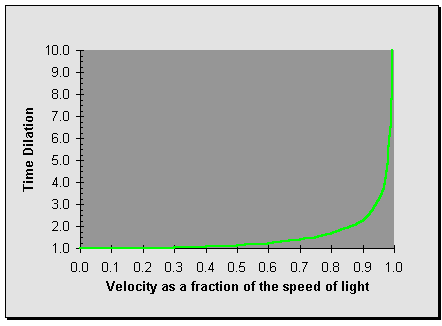
The idea of a temporally distributed civilization is something that I began to develop in my 2012 100YSS presentation, “The Large Scale Structure of Spacefaring Civilization.” There I observed that we tend to think of human expansion into the universe as distribution in space, but in a relativistic universe, distribution in time cannot be separated from distribution in space. As the engineering innovations of industrial-technological civilization bring us gradually ever closer to the possibility of a 1G starship, our spatial distribution in the universe will at the same time become a temporal distribution through time dilation: the faster we go and the farther we go, the more time will have elapsed at our point of origin.
Time dilation is not only subject to misconception, but the way in which the “twin paradox” has been commonly presented seems almost as though calculated to elicit a poignant response: one of two twins remains on Earth, while another flies to a distant star at relativistic velocities. When the traveling twin, who has experienced acceleration, returns, the twin who has remained on Earth is now old, while the returning traveler is yet young. The greater the speed of travel, the greater the time dilation effect, so that a 1G starship would allow a traveler to not only exceed the age of a twin, but to exceed the age of the Earth, and this would be sad indeed. It sounds like madness to undertake such a voyage.

[Image credit: http://physicsforme.wordpress.com/2012/04/26/the-twin-paradox-in-relativity-revisited/]
Even if many or most individuals are dissuaded from interstellar travel by time dilation, or are risk averse and would never fly to the stars out of fear, it would ludicrous to argue that no one will take the risk, or that no one would be willing to leave the world behind. Even under the conditions of total separation I strongly suspect that there would be a few individuals and small groups willing to cut their ties to their homeworld and go on a one-way journey to the stars. And it is highly likely that among the first to make the journey to the stars, some will never be heard from again (Some of these may prove to be questions as fascinating to the public as the fate of Amelia Earhart.) They will be as lost to us as early ships lost at sea. Perhaps they will go farther than any of us; perhaps they will be waiting for us at the edge of the universe when we finally arrive, en masse, as a civilization.
This, however, represents a limiting case of relativistic travel. To give an accurate picture of the large scale structure of spacefaring civilizations, the twins paradox must be recast in terms of populations rather than individuals. As in evolutionary biology, it is the population that is the unit of selection, although in this context it is a human population that is temporally selected, or rather selects itself. The vanguard of spacefaring civilization will consist of populations who desire their differentiation from the civilization of source (eocivilization); this process will be strongly selective of those who feel alienated from the civilization of their birth and are willing to abandon it.
There will be long-term socio-political consequences of the establishment of initial interstellar settlements by those least attached to the civilization that made spacefaring possible, but these socio-political consequences will be limited by the small size of the communities in question. In the same way that any communicating civilization would be overtaken by any traveling civilization, because of the technological innovations that would occur during the period of time while waiting for a signal to travel interstellar distances and then return, so too any civilization that experiences less time as a result of time dilation would be overtaken by a non-accelerated center of civilization. Later technological innovations from the original center of civilization will eventually overtake the vanguard, but the scales of space, time, and technology involved will mean that it will be an open question whether these vanguard communities will have transformed themselves into something unrecognizable in the interim.
It is likely that the greater part of innovation in propulsion technologies (and therefore that attainment of greater velocities) will occur wherever the greater part of the human population is to be found, which in the initial stages of a spacefaring civilization means that most advances in propulsion technologies will occur on a given species’ home planet while its initial starships will be isolated from these innovations. Thus technologies on the home world will surpass those who have made the first interstellar journeys.
In so far as such interstellar travel is continually improved and refined, it would not be isolated groups, but rather large groups that will eventually travel, or many individuals or small groups who could rendezvous at an appointed place and time. Collectively, such a group of travelers would bring its contemporaneous civilization along with it—they would both travel to the stars, and have their familiar civilization, although that civilization would not continue to mirror the civilization of source indefinitely as it independently developed, though later voyages are likely to diverge less from the source of civilization than earlier voyages.
Beyond a certain threshold, when off-planet population clusters approach the levels of density required for innovative scientific research on an industrial scale, and as innovations from the original center of the civilization result in cheaper, more effective, and more widely distributed transportation technologies, the bias will shift from the certainties of settled planetary life to the possibilities of life on a larger scope and scale that represents an increase in an order of magnitude of the choices and opportunities available. For the same reasons that populations have steadily moved from rural areas to urban centers, driving further urbanization once urbanization had become a viable way of life for the formerly-rural masses, populations will steadily migrate from settled planetary life to an accelerated life that joins the time-dilated community once this becomes a viable way of life for the civilized masses.
As civilization enlarges in scope, it is subject to a greater degree to the natural forces that govern the large scale structures of space-time. At the largest cosmological scale, the theory of relativity would prove to be constitutive of civilization. The farther a civilization extends in space, the greater number of frames of reference it encounters and the greater the diversity of these frames of reference. It is this process that will yield a temporally distributed civilization.
In the context of a temporally distributed civilization, a distinction must be made between the chronological age of a civilization and the temporal span that a civilization covers, since the cosmological distribution of centers of civilization at relativistic velocities means that accelerated populations cover a greater span of time than unaccelerated populations remaining at the original source of civilization. The temporal span of a civilization is the total portion of the age of the universe occupied by a given spacefaring civilization. This temporal span will be much larger in its scale of time than the chronological age of the civilization.
More significantly, distinct centers of civilization widely dispersed in space and time (i.e., separated by a significant temporal span) may be chronologically very close in age. When velocities close to the speed of light are attainable, this temporal span may be dramatic. Centers of civilization separated by thousands or even millions of light years may be chronologically only a few years apart, so that essentially the same civilization exists millions of years apart in terms of its temporal span. Separation of months or years or even decades amounts to little more than a rounding error in terms of the scale of time involved.
This distribution of essentially the same civilization throughout widely separated spans of time will result in a very high degree of existential risk mitigation, since these temporally distributed centers of civilization will not even be subjected to the same natural disasters occurring on a cosmological scale, as they will inhabit different ages of the universe. A sterilizing gamma ray burst may doom the unfortunate center of civilization coeval with that disaster, but other coeval centers of civilization will be spared this particular risk, though they may be subject to other existential risks.
These coeval centers of civilization, approximately the same chronological age, but widely separated across the universe as faster and farther travel takes us ever greater distances from the original source of our civilization, will be like stepping stones across the cosmos. An interstellar traveler might pass from one arm of the Milky Way galaxy to another, always having a familiar center of civilization to stop and to pause. Some would choose to stay and maintain that center of civilization (and its coeval character), while others may choose to go farther. Such stepping stones across the cosmos might eventually take us from galaxy to galaxy, cluster to cluster, and supercluster to supercluster.
The new centers of civilization that result from interstellar voyaging, and which can serve as stepping stones across the cosmos, will be connected to each other as peer civilizations. It is only when you seek to retrace your steps that you come “back” to a near-peer civilization (i.e., a civilization sufficiently removed in time that it is no longer a peer simpliciter), now removed by degrees of separation in time, or even to a non-peer civilization, the farther and faster you go back to the former source of civilization. If homeworld civilization stagnates, one might even return to something like a peer civilization, but even a peer civilization would be unrecognizable, as the continents of Earth rearrange themselves and all our cities and monuments disappear and are replaced by new structures, until the Earth is no longer habitable.
The cosmos itself forces us to confront the fact that you can’t go home again. Earth is our cosmological home, and once we leave it for the stars we will not be able to return to the world that we left behind. But we will take our terrestrial civilization with us to the stars, and these new centers of civilization established by interstellar voyaging will possess the knowledge, redundancy, and autonomy requisite to mitigating any existential risk.
The civilization that I have described will be both strikingly similar to and radically different from the civilization that we know today, and we will have to formulate new modes of self-understanding in order to conceptualize our place within such a cosmic order. The advent of temporally distributed civilization will mean that the historical consciousness that human civilization has laboriously constructed, and which we have greatly expanded since the formulation of scientific historiography, will have to be expanded and extended once again by the expanded and extended human experience of a civilization that spans the geometry of spacetime across the galaxy and eventually across the universe, step by step.

Spacecraft and Their Messages
Just over 8300 people have now signed the petition supporting the New Horizons Message Initiative. The approach of the 10,000 figure reminds me to jog those who haven’t to stop by the site to sign the petition. For those not yet aware of the NHMI, the idea is to upload a crowdsourced package of images and data to the New Horizons spacecraft once it has completed its science mission at Pluto/Charon and any Kuiper Belt Object within range.
Jon Lomberg’s team calls the NHMI a ‘Voyager Golden Record 2.0,’ a worthy goal indeed, and I’ll also mention that the names of the first 10,000 signing the petition will be uploaded along with the images and data. For me, one of the most interesting aspects of the initiative will be to see how the crowdsourcing project works to determine both the form and the content of the message. New Horizons’ principal investigator Alan Stern has signed off on the idea, saying “I think it will inspire and engage people to think about SETI and New Horizons in new ways.”
While we work on developing this self-portrait of our species, it’s interesting to see the new ‘Messages to Bennu!’ campaign that’s developing through the OSIRIS-REx mission, in conjunction with The Planetary Society. OSIRIS-REx stands for — get ready for it — Origins-Spectral Interpretation Resource Identification Security Regolith Explorer. It’s a robotic mission, to be launched in 2016, that will spend more than two years at Bennu, a 500 meter carbonaceous asteroid. A surface sample will then be returned to Earth in 2023.
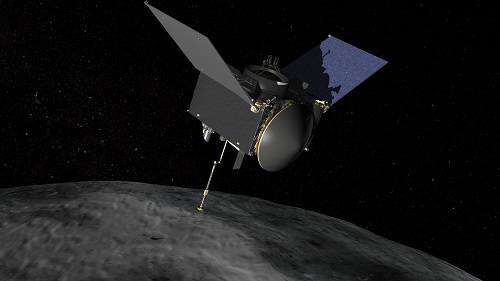
Image: When the OSIRIS-REx asteroid arrives at asteroid Bennu, it will study the asteroid from a distance before swooping down and grabbing a sample. On board the spacecraft will be the names of everybody participating in the “Messages to Bennu!” campaign. Credit: NASA/GSFC/UA.
The ‘messaging’ side of the mission involves putting a microchip with the names of people who have submitted them to The Planetary Society aboard the vehicle. You can sign up to have your name included here. Planetary Society CEO Bill Nye sees the mission of his organization as being ‘to engage the citizens of Earth in space exploration,’ an ongoing campaign that ‘Messages to Bennu!’ incorporates. We can hope that efforts like OSIRIS-REx and the New Horizons Message Initiative help to reawaken an all too lethargic public involvement with space.
The OSIRIS-REx countdown clock actually started on December 9, 2013, looking 999 days ahead to a launch in September of 2016. Principal investigator Dante Lauretta (University of Arizona) clearly likes the mission’s acronym, saying in a UA news release:
“Osiris was formed from pieces scattered across ancient Egypt, where he awoke as the bringer of life and ruler of the underworld. Our spacecraft has a similar story — it will be consist of components fabricated in locations around the world, that once together, will allow us to connect with a near-Earth object that is an accessible remnant from the formation of our solar system.”
As to Bennu, the target asteroid, it is a near-Earth object whose orbit is completed every 436 days, bringing it close to the Earth every six years. The object is considered a B-type asteroid, a subgrouping of the dark, carbonaceous C-type asteroids. These objects are useful for study because they have undergone little processing since the time of their formation. In addition to in situ studies and the sample return, OSIRIS-REx will also help us refine Bennu’s orbit by studying the Yarkovsky effect — the thermal force on the object — constraining the specific properties of the asteroid that make this effect a factor in its future trajectory. That’s useful information to have as we study near-Earth objects and potentially Earth-crossing orbits.

‘Cluster Planets’: What They Tell Us
2500 light years from Earth in the constellation of Cancer lies Messier 67, an open star cluster that is now known to be home to at least three planets. The new worlds, found using the HARPS spectrograph on the European Southern Observatory’s 3.6-meter instrument at La Silla, come as the result of an observation program covering 88 selected stars in the cluster over a period of six years. The finding is noteworthy because we have so few known planets in star clusters of any kind. Moreover, one of these planets orbits a truly Sun-like star.
Image: This wide-field image of the sky around the old open star cluster Messier 67 was created from images forming part of the Digitized Sky Survey 2. The cluster appears as a rich grouping of stars at the centre of the picture. Credit: ESO/Digitized Sky Survey 2 / Acknowledgement: Davide De Martin.
I’m cautious about calling anything ‘Sun-like’ given how loosely that term has been used over the years, but ESO astronomers say the cluster star YBP1194 fits the bill: It has a similar mass, and shows both chemical abundances and temperatures very close to Sol’s. Of the three discovered worlds, two orbit G-class stars similar to the Sun (the other is YBP1514), while the third orbits the red giant S364. The first two have roughly one-third the mass of Jupiter, orbiting their host stars in seven and five days respectively, while the third, more massive than Jupiter, orbits the red giant in 122 days.
Because most stars are thought to emerge from clusters, the small number of planets found in them has been a puzzle, spurring the recent work, which was led by Anna Brucalassi (Max Planck Institute for Extraterrestrial Physics). Says Brucalassi:
“In the Messier 67 star cluster the stars are all about the same age and composition as the Sun. This makes it a perfect laboratory to study how many planets form in such a crowded environment, and whether they form mostly around more massive or less massive stars.”
Messier 67 contains about 500 stars and is an open cluster, a stellar grouping that has emerged from a single gas and dust cloud in the relatively recent past. Such clusters are normally found in the spiral arms of galaxies like ours. Globular clusters, on the other hand, are the much larger, spherical collections of stars that orbit around the center of the galaxy. Although a handful of planets have been found in open clusters (Messier 44 and NGC 6811 are other examples), no planets have yet turned up in the far more ancient globular clusters.
The lack of detected planets in open and globular clusters has been under discussion for some time now. From the paper:
To explain the dichotomy between field and cluster stars, it has been suggested that the cluster environment might have a significant impact on the disk-mass distribution. Eisner et al. (2008), studying disks around stars in the Orion Nebula Cluster (ONC), proposed that most of these stars do not possess sufficient mass in the disk to form Jupiter-mass planets or to support an eventual inward migration.
Brucalassi’s work, however, leads in a different direction. The paper continues:
van Saders & Gaudi (2011), in contrast, found no evidence in support of a fundamental difference in the short-period planet population between clusters and field stars, and attributed the non-detection of planets in transit surveys to the inadequate number of stars surveyed. This seems to be confirmed by the recent results.
Planets in open star clusters, in other words, are likely to be as common as those around isolated stars, a finding that draws not just from Brucalassi and team’s work but also from a number of recent observations discussed in the paper. The researchers continue to study M67 to examine the mass and chemical makeup of stars with and without planets.
The paper is Brucalassi et al., “Three planetary companions around M67 stars,” accepted for publication in Astronomy & Astrophysics. See also Pasquini et al., “Search for giant planets in M67 I. Overview” (preprint). And take note of Henry Cordova’s “The SETI Potential of Open Star Clusters,” which ran all the way back in 1995 in Vol. 1, No. 4 of SETIQuest, an early and prescient contribution.

